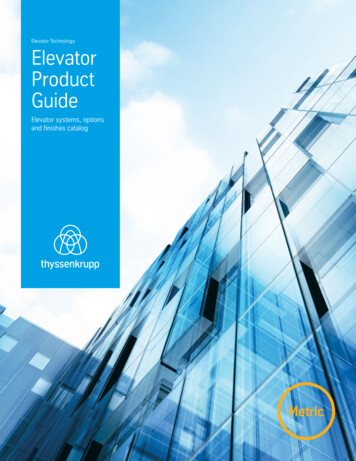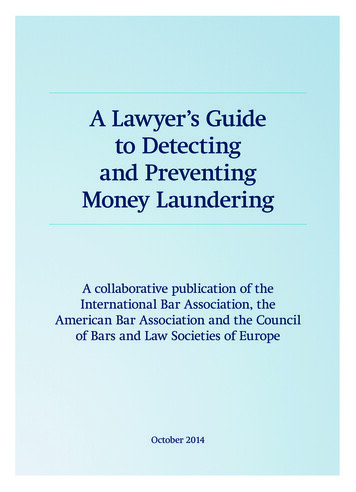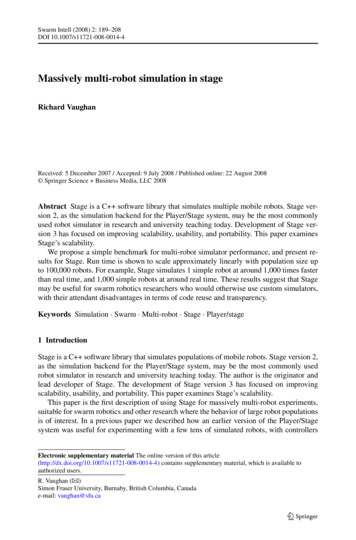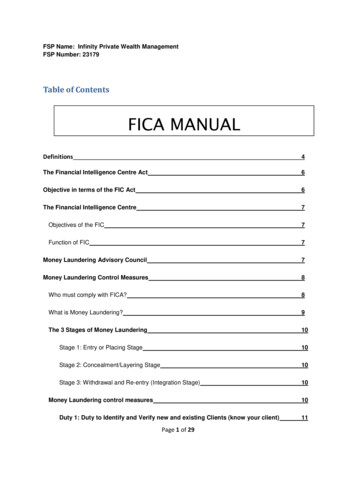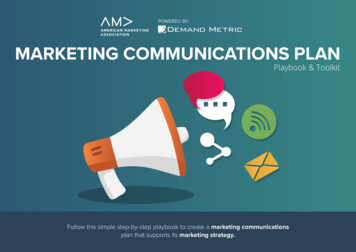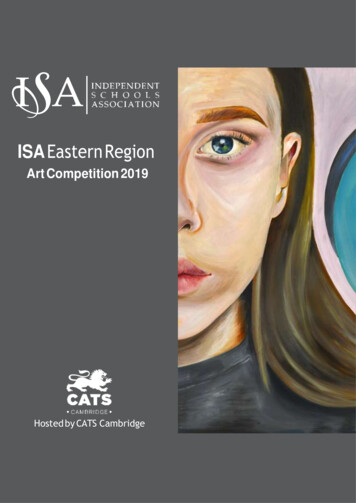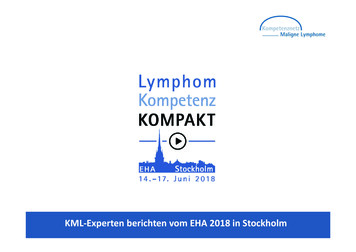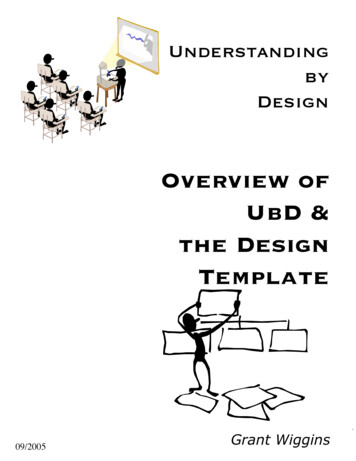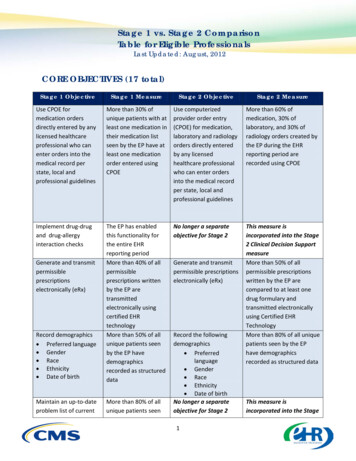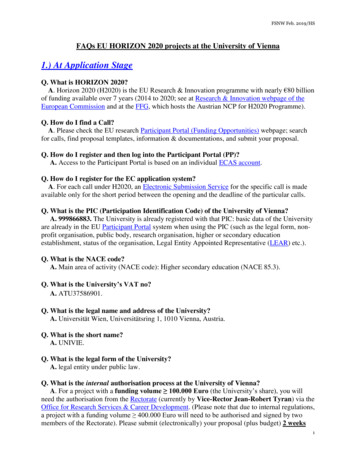
Transcription
FSNW Feb. 2019/HSFAQs EU HORIZON 2020 projects at the University of Vienna1.) At Application StageQ. What is HORIZON 2020?A. Horizon 2020 (H2020) is the EU Research & Innovation programme with nearly 80 billionof funding available over 7 years (2014 to 2020; see at Research & Innovation webpage of theEuropean Commission and at the FFG, which hosts the Austrian NCP for H2020 Programme).Q. How do I find a Call?A. Please check the EU research Participant Portal (Funding Opportunities) webpage; searchfor calls, find proposal templates, information & documentations, and submit your proposal.Q. How do I register and then log into the Participant Portal (PP)?A. Access to the Participant Portal is based on an individual ECAS account.Q. How do I register for the EC application system?A. For each call under H2020, an Electronic Submission Service for the specific call is madeavailable only for the short period between the opening and the deadline of the particular calls.Q. What is the PIC (Participation Identification Code) of the University of Vienna?A. 999866883. The University is already registered with that PIC: basic data of the Universityare already in the EU Participant Portal system when using the PIC (such as the legal form, nonprofit organisation, public body, research organisation, higher or secondary educationestablishment, status of the organisation, Legal Entity Appointed Representative (LEAR) etc.).Q. What is the NACE code?A. Main area of activity (NACE code): Higher secondary education (NACE 85.3).Q. What is the University’s VAT no?A. ATU37586901.Q. What is the legal name and address of the University?A. Universität Wien, Universitätsring 1, 1010 Vienna, Austria.Q. What is the short name?A. UNIVIE.Q. What is the legal form of the University?A. legal entity under public law.Q. What is the internal authorisation process at the University of Vienna?A. For a project with a funding volume 100.000 Euro (the University’s share), you willneed the authorisation from the Rectorate (currently by Vice-Rector Jean-Robert Tyran) via theOffice for Research Services & Career Development. (Please note that due to internal regulations,a project with a funding volume 400.000 Euro will need to be authorised and signed by twomembers of the Rectorate). Please submit (electronically) your proposal (plus budget) 2 weeks1
FSNW Feb. 2019/HSprior deadline to the Office for Research Services & Career Development. We recommend toinform your Faculty/Dean in due time about the proposal submission. If the funding volume 100.000 Euro (the University’s share) then the Dean (or Vice-Dean) of your Faculty authoriseyour project application.Q. Who is the Contact Person?A. In the administrative forms, the ‘Person in Charge of the Proposal’ is usually the PrincipalInvestigator (PI) (or the Project Manager). Please note, for all ERC applications, a contact personat the Host Institution is also required. Here please name (as research coordinator) AmyRadlberger with the email address eu.fsib@univie.ac.at and phone number 43-1-427718228.Q. Do I need to sign a confidentiality agreement during proposal preparation?A. Particularly with collaborative projects, future participants may wish to exchangeinformation about their respective methods of work, scientific achievements etc. Some of thisinformation may be confidential and should be protected. Therefore, it may be necessary oradvisable to sign a confidentiality agreement before initiating substantial negotiations regardingthe proposal preparation and the future work. The technology transfer office will assist you withthis. Please contact techtransfer@univie.ac.at if you have any questions.Q. What are the Ethics Appraisal Procedure under H2020?A. The Ethics Appraisal Procedure concerns all activities funded in H2020 and includes theEthics Review Procedure, conducted before the start of the project, as well as the Ethics Checksand Audits. Guidance of how to complete your ethics self-assessment can be found here.Q. Which costs do I need to include in my proposal?A. You can include all the standard direct costs that apply to any research grant: staff costs (inaccordance to the Collective Bargaining Agreement for University Staff (Kollektivvertrag; seelast page) as gross-gross salaries (i.e., including the employer’s contribution), consumables,equipment, travel, costs for open access publications, subcontracting and audit. Staff costs needto be valorised with 2-3% over the project lifetime. An external audit, i.e., a Certificate on theFinancial Statement (CFS), is obligatory at the end of the project if the funding of the total directcosts is 325.000 Euro: please calculate approx. 0.55% of the direct costs under ‘other directcosts/goods and services costs’ for an audit. Under H2020, you can also include the costs ofpermanent academic staff, but you should be aware that these costs will only be paid on the basisof an appropriately completed timesheet. You also need to include indirect costs (overheads)which is a flat rate of 25% of the direct costs (excluding subcontracting costs). If you apply, orhave successfully applied for equipment, keep in mind that only depreciation costs will bereimbursed by the EU (details on depreciation rates used at the University can be provided by theUniversity Office for Accounting and Finance). Full financing must be assured and planned inadvance. Please note: in the MSCA programmes flat rate costs categories are used (and may leadto a funding gap); therefore please contact the Office for Research Services & CareerDevelopment in due time. Please contact this Office also for advise on EU budgeting and forExcel tools to support you in planning and budgeting your EU project.Q. If my project is successful, what will I actually receive?A. The EC will reimburse projects at 100% of all costs; i.e. the total of direct costs (100%funding rate) plus indirect costs (25% funding rate). Please note, under the MSCA fundingscheme flat rates apply.2
FSNW Feb. 2019/HS2.) At Contract Preparation & Grant Signature StageQ. What is the Identity and Access Management (IAM) or role management in theParticipant Portal (PP)A. Each person has to register for an ECAS account. The unique identifier for a physicalperson is the (University) e-mail address used for the creation of the PP (ECAS) account.Depending on their role in a project, users can have access to grant preparation, see Rolemanagement changes in brief at this link.Q. What Roles need to be added to EU Participant Portal (grant management)?A. The EC only approves/modifies the 'top' role in the project consortium, i.e., the PrimaryCoordinator Contact (PCoCo) who will then grant access rights to the project to the contactpersons of other beneficiary organisations (Participant Contact (PaCo)). The PaCo can appointfurther roles to the project within their own organisation such as Team/Task Members (withread-only rights). To do that go to the My Projects page under the My Area section, select ProjectConsortium (PC; click the yellow button), select Edit Roles and then Add Roles. Each beneficiaryneeds also to select Project Legal Signatory (PLSIGN) and the Project Financial StatementSignatory (PFSIGN) (see FAQs below); these roles for the University are already in the EUParticipant Portal specified by the Legal Entity Appointed Representative (LEAR) of theUniversity of Vienna (if not, then please contact the LEAR).Q. Who is the Legal Representative/ Legal Signatory (LSIGN)/ Project Legal Signatory(PLSIGN) and is authorised to sign Grant/Consortium Agreement?A. Currently, Vice-Rector Jean-Robert Tyran (or the Dean of your Faculty if the fundingvolume is 100.000 Euro; if the Dean is not yet in the system please contact the LEAR – seeFAQ above). In the EU Participants Portal you need to be linked, by the Coordinator, to yourspecific H2020 project, then you can choose/tick the PLSIGN; the given email of the PLSIGN(Vice-Rector Jean-Robert Tyran) is eucontract@univie.ac.at).Q. Who has the role of Financial Statement Authorised Signatory (FSIGN) and the role ofProject Financial Statement Signatory (PFSIGN)?A. The role of FSIGN and PFSIGN is currently held by Bettina Filz, Angelika Puchberger,Anna Rennhofer, and Dragana Markovic from the University Office for Accounting and Finance.FSIGNs are persons authorised to sign financial statements in EU grants on behalf of theirorganisation. In the EU Participants Portal you need to be linked to the EU project then you canchoose/tick the PFSIGNs (see above).Q. What are the bank details of the University of Vienna for EU projects?A. Account number: 00000 675 447, Bank sorting code (BLZ): 32000BIC: RLNWATWW, IBAN (Currency: EURO): AT08 3200 0000 0067 5447Bank: Raiffeisenlandesbank NÖ-Wien AG, Friedrich-W.-Raiffeisen-Platz 1, A-1020 Vienna,Austria.Q. What is the purpose of EU Grant Agreement Preparation?A. The purpose of this phase is to finalise the details of the work (i.e., Description of Action(DoA) to be carried out under the Grant Agreement (GA) within the associated project budget, as3
FSNW Feb. 2019/HSwell as to establish the legal and financial information needed to finalise the GA. The Office forResearch Services & Career Development, if required, will support and advise you in legal andfinancial matters of your H2020 project.Q. Can I sign the Grant Agreement myself?A. No, it will be signed by the legal representative(s) of the University, currently by the ViceRector, Jean-Robert Tyran (or if the funding is 100.000 Euro by the Dean/Vice-Dean). Pleasesend all documents in due time to the Office for Research Services & Career Development.Q. What is the difference between the Grant Agreement and the Consortium Agreement?A. The Grant Agreement is the principal agreement between the EC and the grant holder. Formulti-partner projects (i.e., collaborative projects), the grant holder is always the Coordinator andthe consortium partners bind themselves to the terms of the Grant Agreement by signing theAccession Form. Linked third parties do not sign either the agreement or an accession form. Incollaborative projects, the consortium usually establish a Consortium Agreement (CA). The CAhowever is signed solely between the consortium partners and addresses the issues not covered inthe Grant Agreement. In case of conflicting terms, the Grant Agreement shall always overrule theCA.Q. Why do we need a Consortium Agreement (CA)?A. An effectively drafted CA can, and should, fulfill multiple purposes within a project thatwill help to ensure that the process of producing project deliverables and the achievement ofproject outcomes are made as efficient as possible. It should not be viewed as simply a piece ofadministrative paperwork to be completed as an afterthought to the main work of the project – itshould be completed in advance of that work and serve to underpin the process. In particular, theCA is meant to cover such issues between the consortium partners as the management structure,liabilities, reporting, budget, workplans, publication regulations, intellectual property (IP)ownership, access rights, dispute resolution and commercialisation regulations. The EC requiresconcluding a CA in most cases to avoid time-consuming disputes during or after the project.Q. For an EU project, when should we draw up and sign our Consortium Agreement?A. The CA is deemed to have been concluded before the signature of the Grant Agreementbetween the Commission and the project coordinator. Therefore, the CA should be drafted asearly as possible in the project development process. As already noted, a well drafted CA canplay a key role in the project process by providing a coherent framework for operationaldevelopment by the project team. It also requires the project partners to think carefully, at anearly stage, about what they see their role within the project as being, and, if appropriate, wherethey would like it to go in the future. If the creation of a CA is left until later in the projectprocess, it may become increasingly difficult to obtain agreement from project partners as to theirrespective responsibilities and future ambitions for project outcomes and deliverables.Q. Is there an official model Consortium Agreement provided by the EC?A. The University Office for Research Services & Career Development generally recommendsthe DESCA model. However, the precise content of a CA will vary according to the nature andscope of the project at issue. Therefore, project partners should, wherever possible, avoid theapproach of simply adopting a basic template and ‘filling in the blanks’, as this approach maywell fail to address important issues specific to that individual project, or type of project. It isessential that each of the project partners spend adequate time assessing the construction of the4
FSNW Feb. 2019/HSCA in order to work through and understand the implications of the terms chosen, as regards theirparticular participation in the project. Please contact the Legal Advisors at the University Officefor Research Services & Career Development: Eva Neweklowsky, Nathaly Thiel, and KamillaTrummer) at an early stage for custom-made consortium agreements or adaption of the DESCAcontract model to the respective project. For IP related issues you may also contact thetechtransfer@univie.ac.at.Q. Can I sign the Consortium Agreement myself?A. No, it will be signed by the legal representative(s) of the University (see FAQs above). TheDepartments, Institutes or Principal Investigators (PIs) cannot legally bind the University, and allcontracts should state the University as the contracting party, not the Department/Institutes or thePI. A signature from anyone other than authorised representative(s) of the University may make acontract invalid. All contractual paperwork should be sent therefore to the Legal Advisors (seeemail contact details above).Q. What are the key issues for the University of Vienna in a Consortium Agreement?A. Your Legal Advisor will endeavour to get the best possible terms to ensure fair voting ruleson consortium matters; fair sharing of revenue between joint creators of intellectual property;minimal delays to publication of results and appropriate protection of background intellectualproperty that you bring to the project.Q. I would like to withdraw from my EU project, how do I do that?A. Almost all Consortium Agreements will have a section dedicated to withdrawal procedures.In case the Consortium Agreement does not provide these guidelines, the EC Contract terms canbe followed. As a general rule, the other Consortium partners would need to give their(unanimous) approval for your withdrawal, which shall not be unreasonably withheld.Q. Where can I get information on Ethics and Data Protection for EU projects?A. EC published a guideline on ethics and data protection and can be found via this a/ref/h2020/grants manual/hi/ethics/h2020 hi ethicsdata-protection en.pdf. Information to the Ethics Committee of the University of Vienna can befound via this link: mittee/. The dataprotection office of the University of Vienna can be contact via this link https://dsba.univie.ac.at/.3.) At Post Award StageQ. Where can I find guidance for implementing and managing an EU research grant?A. Please find detailed information for project management at the University at the internalwebsite “Services for External Funding” (intranet - you need to log-in with your email addressand password). The University Office for Accounting and Finance assists you in implementing aproject (e.g. to get the internal order number), in financial reporting and/or in accounting. Thefinancial statements (Forms C) will have to be signed electronically and transmitted exclusivelyvia the Participant Portal. The roles of FSIGN & PFSIGN of the University of Vienna are heldcurrently by Bettina Filz, Angelika Puchberger, Anna Rennhofer, and Dragana Markovic fromthe University Office for Accounting and Finance.5
FSNW Feb. 2019/HSQ. Where can I get Project Management Services?A. The Research Services offers different levels of project management services for thirdparty funded projects: -management/; contactMichael Wimmer (m.wimmer@univie.ac.at) or Stephanie Fogel (Stephanie.fogel@univie.ac.at)for more information.Q. How to employ personnel?A. For employment related issues you may contact the Human Resources Department. Weadvise you to get in contact with the Human Resources Department as soon as possible in orderto initiate the employment contract. Please contact them and/or check their website (or theintranet 'Drittmittelservices') to request necessary forms for the employment contract andinformation about the Kollektivvertrag (salary scales)/ taxes/ health insurance/ visas etc. Pleasenote that personnel who are not employed full-time on an EU grant need to have time sheets inorder to claim their costs.Q. What are the rules regarding audit?A. The audit certificate is called a Certificate of Financial Statement (CFS) and is onlyrequired at the end of the project, if cumulative expenditure of the direct costs exceeds 325.000.For audits please contact in due time the University Office for Accounting and Finance; thisdepartment can provide you also with a list of external auditors for EU projects.Q. What is the method of funding and how does this affect my budget?A. Your EC budget is a total that cannot be exceeded. The EC contribution consists of onesingle pre-financing payment at the start of each project followed by interim payments and a finalpayment.Q. What are the VAT rules of H2020 grants?A. Non-recoverable VAT (Mehrwertsteuer, MWST) is an eligible cost under H2020.Q. What are eligible and non-eligible costs within H2020 projects?A. To be eligible for refund costs must be: actual (“real, not estimated”), economic (bestvalue for money) and necessary for the project, incurred during the duration of the project,recorded in the accounts (or third parties), excluding non-eligible costs, not give rise to profit.Non eligible costs are: interests owed, exchange losses, debt and debt service charges, excessiveor reckless expenditure, any costs which do not meet the conditions to be eligible costs.Q. What are the Open Access and Data Management requirements under Horizon 2020?A. All projects which are funded or cofunded by Horizon 2020 are required to ensure free ofcharge online access for any user to scientific publications relating to its results. Guidelines forOpen Access under H2020 can be found here. In addition, under Horizon 2020, in some areas(e.g., FET, ERC, MSCA some Societal Challenges) beneficiaries will be required to deposit theresearch data generated by the project in a research data repository and enable third parties toaccess this data free of charge. If you have general questions regarding data management at theUniversity please contact dmp@univie.ac.at (or intranet: Data Management Plan nitiale/d/thema/datenmanagementplan-dmp/). There aretwo main routes which can be followed for enabling open access to publications: Self archiving(also referred to as green open access) means that the published article or the peer-reviewedmanuscript is archived (deposited by the author/or representative) in an online repository before6
FSNW Feb. 2019/HSor after its publication. Sometimes an embargo period is set by the publisher; or Open accesspublishing (also referred to as gold open access) means that an article is immediately provided inopen access mode as published. This method often incurs an additional fee. Open access feesduring the lifetime of the project are eligible under Horizon 2020 and should be included in yourcosts at proposal stage. It is however currently not possible to fund fees which are incurred afterthe project has finished and this may be an additional cost to you. These fees could be funded forexample from the remaining project overheads. If you prefer self-archiving, then please be awarethat you must ensure Open Access to the publication within 6 months of depositing the final peerreviewed manuscript in a repository. For the Social Sciences & Humanities this is extended to 12months. In the database SHERPA-RoMEO http://www.sherpa.ac.uk/romeo/index.php, allavailable information concerning the conditions for an open access publication is available formany journals and publishers. The University has an Open Access Office who can advise andsupport you on all issues regarding Open Access. The University is also part of the OpenAIREinitiative. Please contact Gerda McNeill: openaireaustria@univie.ac.at.H2020 – major types of actionsTypeCodeFundingResearch &Innovation ActionInnovation ActionRIA100%IA100%*Coordination &Support ActionMarie SklodowskaCurie ActionsEuropean ResearchCouncil nths30-36months12-36monthsdepends onthe type60 monthsAim of ActionCollaborative research & development project( 3 entity)Collaborative innovation project ( 3 entity) toplan/design/produce processes, products &services - activities close to the marketAccompanying measure activities, studies,networking ( 1 entity)Training and career development - for furtherdetails see the MSCA FAQsSupport excellent PIs and their research teams(usually 1 entity)* Funding rate for the University.7
A. Access to the Participant Portal is based on an individual ECAS account. Q. How do I register for the EC application system? A. For each call under H2020, an Electronic Submission Service for the specific call is made available only for the short period between the opening and the deadline of the particular calls. Q.

